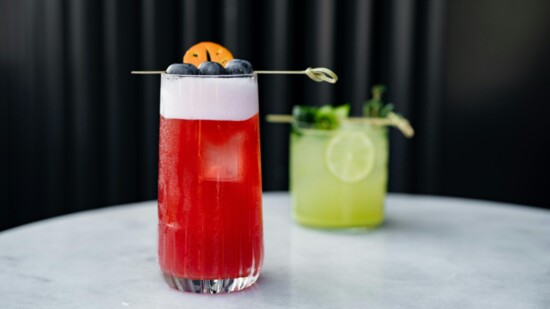In an era where sipping on a cocktail no longer necessitates a buzz, the rise of mocktails and low ABV drinks is redefining what it means to spend a night out on the town. Drinking has evolved to mean more camaraderie and fewer embarrassing moments—and bartenders across town are picking up on the shift. “I started seeing non-alcohol spirits around here about ten years ago, but they didn’t gain much traction until recently,” says Nicole Costas, co-owner of Arcadia in the Old Port. “During the pandemic, people started focusing on their health, and that’s when non-alcoholic beverages really took off.” Kristen Mixter, bar manager at Crispy Gai, noticed a similar trend. “I think with the pandemic, people found themselves making cocktails at home since they couldn’t go out to bars, and they may have realized the impact of increased drinking wasn’t sustainable. Now, they’re turning to mocktails and low ABV drinks to fill that interest.”
What makes a great mocktail? For starters, it should receive the same attention and care as an alcoholic beverage. “What can be said about a successful mocktail can be said about a successful cocktail, and that’s getting something unexpected that you couldn’t necessarily make for yourself,” Costas says. “I treat a mocktail the same way I do a cocktail,” adds Mixter. “You want to make sure it’s balanced and that everything you’re using is as fresh as possible. You also want to think about other components: How can you add a bitter element? What about something herbaceous?” Marcus Alcantara, co-owner of Paper Tiger, emphasizes the importance of four flavor profiles: sour, sweet, herbal, and bitter. “The current palate of drinkers in the general public is more educated and knowledgeable than it has been in the past,” he says. “These four elements combined are what make a great, unique, complex beverage.”
Some drinkers may feel a bit of hesitation upon seeing the going price for a mocktail, which is often only a few dollars less than an alcoholic beverage. “We could easily make you a house lemonade with fresh lemon juice, a bit of simple syrup, and some water,” Alcantara says, “but our mocktails include other ingredients that we put a ton of work into. Our peach-sage shrub, for instance, has fresh sage and fruit from local farms. These small touches require more work and more love.” Mixter encourages patrons to think about it this way: “If there’s a mocktail that’s $8 and a cocktail that’s $11, whoever made the cocktail was likely relying on the flavor profile of the spirit. If you eliminate that completely, you need to source a wide variety of other ingredients to match the missing flavors. Ultimately, there’s a lot more work that goes into a mocktail—at least one that has interesting stuff going on.”
For those not looking to completely abstain from alcohol, low ABV drinks like spritzes are a great option. “We all know about aperol spritzes—they’re bubbly, they’re refreshing, and you can have a bunch of them without becoming wildly intoxicated or embarrassing yourself in front of your friends,” says Alcantara. “I like to play a game called ‘Will It Spritz?’ with other cocktails. Take a gimlet, for example: the ingredients are gin, lime, and sugar. Instead of having a compact cocktail, make it in a taller glass, add some ice, and top it with soda water. It’s the same amount of alcohol, but you’re increasing the volume, which reduces the ratio and elongates the drink.”
Incorporating fresh, high quality ingredients is the first step toward making elevated mocktails and low ABV beverages at home. “There are certain things I fall back on, like using teas and vinegar-based shrubs for another element of flavor and nuance,” says Mixter, who suggests brewing tea and turning it into a flavorful syrup by adding a bit of sugar. Alcantara recommends spices: “Cardamom, a stick of cinnamon, a little bit of shaved nutmeg on top—anything in that realm really takes a drink over the top," he says. “There are tons of cool ingredients out there like bitters and hopped waters, and exploring nonalcoholic spirits can be really helpful, too. Just being willing to try new things and stocking your bar with good, quality ingredients is a great place to start,” adds Costas.
Abstaining from alcohol is a personal choice, but patrons in Portland should know that mocktails and low ABV drinks are not sacrifices—rather, they can be stars. “The majority of Crispy Gai's staff right now has chosen to stop drinking, and being surrounded by people who choose not to drink has led me to put more time and care into the research and development of no- and low-ABV beverages," says Mixter. "I’m surrounded by professionals who have been in this industry for a really long time, and they want quality options. It’s been a really good learning experience.”
“Drinking today is more about camaraderie than it is about getting drunk.”
"When shrubs and juices are made from scratch, they don’t need alcohol to be delicious and enjoyable."
